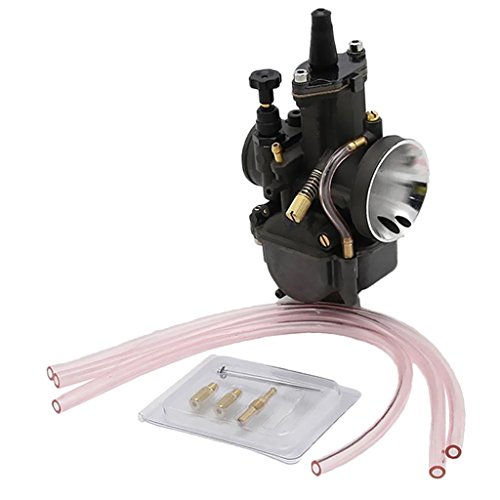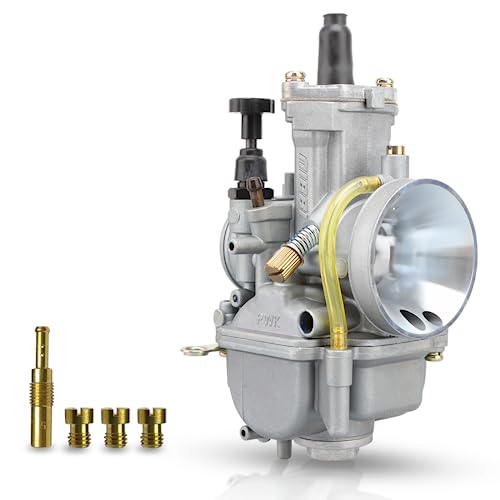The carburetor is one of the most essential components of a motorcycle's engine, responsible for mixing fuel and air to create a combustible mixture that powers the bike. Understanding its intricacies can be vital for any motorcycle enthusiast. In this article, we will explore the anatomy of a carburetor and decode its inner workings.
30mm Carburetor with Power Jet for Honda Hawk 250
Upgrade your Honda Hawk 250 with the powerful 30mm Carburetor equipped with a Power Jet
Product information
Product Review Score
4.61 out of 5 stars
169 reviewsProduct links
At its core, a carburetor consists of four main parts: the fuel bowl, a series of jets and valves, the throttle, and the venturi. The fuel bowl holds the fuel and contains a float that controls the fuel level. As the fuel level rises, the float closes off the fuel flow, preventing overflow.
The jets and valves are responsible for regulating the flow of fuel and air. The main jet controls the amount of fuel entering the carburetor, while the idle jet allows fuel to flow at low throttle openings. The choke valve, located at the top of the venturi, regulates the amount of air allowed into the mixer circuit to aid engine starting.
The throttle, controlled by the rider, determines the amount of air flowing into the engine. It is connected to the throttle cable, allowing the rider to increase or decrease the amount of air, which in turn affects the speed and power of the motorcycle. The venturi, a narrow section in the carburetor, increases the speed of the incoming air, creating a pressure difference and drawing fuel into the air column.
NIBBI 28MM Carburetor for Hawk 250 Motorcycle
Upgrade your Hawk 250 Motorcycle with the high-performance NIBBI 28MM Carburetor
Product information
$76.99
Product Review Score
4.32 out of 5 stars
135 reviewsProduct links
Fueling the Ride: Understanding Carburetors' Primary Functions
When it comes to motorcycles, carburetors play a crucial role in ensuring proper engine performance and fuel efficiency. These devices, commonly found on older motorcycle models and some modern classics, are responsible for the fuel-air mixture required for combustion. Understanding the primary functions of carburetors can shed light on how they contribute to a motorcycle's overall operation and help demystify their functional mechanism.
1. Mixing Fuel and Air
The primary function of a carburetor is to mix the right amount of fuel with the incoming air to create an optimal mixture for combustion. The carburetor achieves this by utilizing a venturi—a narrow section in the carburetor's body that creates a vacuum effect. As air passes through the venturi, it speeds up and creates low pressure, causing fuel to be drawn out from the carburetor's fuel bowl. This fuel is then atomized into fine droplets by passing through the carburetor's small openings, ensuring it can mix efficiently with the incoming air.
2. Controlling Fuel Flow
Carburetors also have mechanisms to control the amount of fuel delivered based on the engine's demand. The throttle valve, located between the air filter and the venturi, is a crucial component in controlling this fuel flow. As the rider twists the throttle, it opens the throttle valve to allow more air to flow into the carburetor, signaling the need for a higher amount of fuel. By regulating the position of the throttle valve and simultaneously adjusting the fuel flow, the carburetor ensures the engine receives the correct fuel-air ratio at different throttle positions.
3. Maintaining Idle Speed
Another significant function of a carburetor is maintaining the engine's idle speed. The idle circuit, a small passage in the carburetor, provides a steady stream of fuel and air to keep the engine running smoothly when the throttle is closed or slightly open. By fine-tuning the idle circuit, motorcycle manufacturers can ensure that the engine remains stable and doesn't stall during idle conditions. This function contributes to the overall reliability and usability of the motorcycle.
How Carburetors Work: Unraveling the Magic Behind Combustion
Carburetors have been an integral part of motorcycle engines for decades. These ingenious devices are responsible for the perfect blend of air and fuel that results in efficient combustion, propelling the motorcycle forward with power. Although fuel injection has become more prevalent in modern motorcycles, understanding how carburetors work is fundamental in demystifying their functional mechanism.
At its core, a carburetor is a mechanical device that mixes air and fuel in precise proportions. It accomplishes this through a series of interconnected components, which work together to regulate and control the flow of air and fuel into the engine. The main components of a typical carburetor include a throttle valve, a venturi, jets, and a float chamber.
When the rider twists the throttle, the throttle valve opens, allowing more air to enter the engine. The increased airflow passes through the venturi, a narrow section in the carburetor where the air pressure decreases. This drop in pressure pulls fuel through the jets, which are small openings that meter the amount of fuel to be mixed with the incoming air. The fuel is then atomized into tiny droplets and mixed with the air, forming a highly combustible mixture that enters the engine's combustion chamber.
The float chamber, located in the bottom of the carburetor, contains a float and a needle valve. The float ensures a constant fuel level in the chamber, while the needle valve controls the flow of fuel into the float chamber. This system maintains a consistent fuel supply, allowing the carburetor to adapt to varying engine demands and ensure smooth operation throughout different throttle positions.
Troubleshooting Tips: Fine-tuning Carburetors for Optimal Performance
When it comes to getting the most out of your motorcycle's performance, ensuring that the carburetor is fine-tuned is key. The carburetor's primary role is to mix fuel and air in the correct proportions for combustion. However, over time, carburetors can become clogged or misadjusted, resulting in poor performance. Here are some troubleshooting tips to help you fine-tune your carburetor for optimal performance.
1. Clean the Carburetor:
A common issue with carburetors is dirt or debris getting trapped in the various jets and passages. Regularly cleaning the carburetor can help maintain its efficiency. Remove the carburetor from the motorcycle and disassemble it carefully. Soak the carburetor parts in a specialized carburetor cleaner to remove any built-up residue. Use compressed air to blow out the jets and passages, ensuring they are clear and unobstructed before reassembling the carburetor.
2. Adjust the Air-Fuel Mixture:
The air-fuel mixture determines the combustion efficiency and overall power output of the engine. An incorrect mixture can lead to rough idling, stalling, or reduced acceleration. Start by identifying the fuel mixture screw on the carburetor. With the engine warmed up, turn the screw clockwise until it bottoms out, then back it out counterclockwise to the specified number of turns specified in the motorcycle's service manual. This will help optimize the air-fuel mixture for your specific bike and riding conditions.
3. Check the Float Height:
The float height within the carburetor's float chamber plays a crucial role in regulating the fuel level. If the float is set too high or too low, it can result in an incorrect fuel level, affecting the engine's performance. Remove the float chamber cover and carefully measure the float height using a caliper or ruler as specified in the service manual. Adjust the float level until it falls within the recommended range.
The carburetor is one of the most essential components of a motorcycle's engine, responsible for mixing fuel and air to create a combustible mixture that powers the bike. Understanding its intricacies can be vital for any motorcycle enthusiast. In this article, we will explore the anatomy of a carburetor and decode its inner workings.
At its core, a carburetor consists of four main parts: the fuel bowl, a series of jets and valves, the throttle, and the venturi. The fuel bowl holds the fuel and contains a float that controls the fuel level. As the fuel level rises, the float closes off the fuel flow, preventing overflow.
The jets and valves are responsible for regulating the flow of fuel and air. The main jet controls the amount of fuel entering the carburetor, while the idle jet allows fuel to flow at low throttle openings. The choke valve, located at the top of the venturi, regulates the amount of air allowed into the mixer circuit to aid engine starting.
The throttle, controlled by the rider, determines the amount of air flowing into the engine. It is connected to the throttle cable, allowing the rider to increase or decrease the amount of air, which in turn affects the speed and power of the motorcycle. The venturi, a narrow section in the carburetor, increases the speed of the incoming air, creating a pressure difference and drawing fuel into the air column.
Fueling the Ride: Understanding Carburetors' Primary Functions
When it comes to motorcycles, carburetors play a crucial role in ensuring proper engine performance and fuel efficiency. These devices, commonly found on older motorcycle models and some modern classics, are responsible for the fuel-air mixture required for combustion. Understanding the primary functions of carburetors can shed light on how they contribute to a motorcycle's overall operation and help demystify their functional mechanism.
1. Mixing Fuel and Air
The primary function of a carburetor is to mix the right amount of fuel with the incoming air to create an optimal mixture for combustion. The carburetor achieves this by utilizing a venturi—a narrow section in the carburetor's body that creates a vacuum effect. As air passes through the venturi, it speeds up and creates low pressure, causing fuel to be drawn out from the carburetor's fuel bowl. This fuel is then atomized into fine droplets by passing through the carburetor's small openings, ensuring it can mix efficiently with the incoming air.
2. Controlling Fuel Flow
Carburetors also have mechanisms to control the amount of fuel delivered based on the engine's demand. The throttle valve, located between the air filter and the venturi, is a crucial component in controlling this fuel flow. As the rider twists the throttle, it opens the throttle valve to allow more air to flow into the carburetor, signaling the need for a higher amount of fuel. By regulating the position of the throttle valve and simultaneously adjusting the fuel flow, the carburetor ensures the engine receives the correct fuel-air ratio at different throttle positions.
3. Maintaining Idle Speed
Another significant function of a carburetor is maintaining the engine's idle speed. The idle circuit, a small passage in the carburetor, provides a steady stream of fuel and air to keep the engine running smoothly when the throttle is closed or slightly open. By fine-tuning the idle circuit, motorcycle manufacturers can ensure that the engine remains stable and doesn't stall during idle conditions. This function contributes to the overall reliability and usability of the motorcycle.
How Carburetors Work: Unraveling the Magic Behind Combustion
Carburetors have been an integral part of motorcycle engines for decades. These ingenious devices are responsible for the perfect blend of air and fuel that results in efficient combustion, propelling the motorcycle forward with power. Although fuel injection has become more prevalent in modern motorcycles, understanding how carburetors work is fundamental in demystifying their functional mechanism.
At its core, a carburetor is a mechanical device that mixes air and fuel in precise proportions. It accomplishes this through a series of interconnected components, which work together to regulate and control the flow of air and fuel into the engine. The main components of a typical carburetor include a throttle valve, a venturi, jets, and a float chamber.
When the rider twists the throttle, the throttle valve opens, allowing more air to enter the engine. The increased airflow passes through the venturi, a narrow section in the carburetor where the air pressure decreases. This drop in pressure pulls fuel through the jets, which are small openings that meter the amount of fuel to be mixed with the incoming air. The fuel is then atomized into tiny droplets and mixed with the air, forming a highly combustible mixture that enters the engine's combustion chamber.
The float chamber, located in the bottom of the carburetor, contains a float and a needle valve. The float ensures a constant fuel level in the chamber, while the needle valve controls the flow of fuel into the float chamber. This system maintains a consistent fuel supply, allowing the carburetor to adapt to varying engine demands and ensure smooth operation throughout different throttle positions.
Troubleshooting Tips: Fine-tuning Carburetors for Optimal Performance
When it comes to getting the most out of your motorcycle's performance, ensuring that the carburetor is fine-tuned is key. The carburetor's primary role is to mix fuel and air in the correct proportions for combustion. However, over time, carburetors can become clogged or misadjusted, resulting in poor performance. Here are some troubleshooting tips to help you fine-tune your carburetor for optimal performance.
1. Clean the Carburetor:
A common issue with carburetors is dirt or debris getting trapped in the various jets and passages. Regularly cleaning the carburetor can help maintain its efficiency. Remove the carburetor from the motorcycle and disassemble it carefully. Soak the carburetor parts in a specialized carburetor cleaner to remove any built-up residue. Use compressed air to blow out the jets and passages, ensuring they are clear and unobstructed before reassembling the carburetor.
2. Adjust the Air-Fuel Mixture:
The air-fuel mixture determines the combustion efficiency and overall power output of the engine. An incorrect mixture can lead to rough idling, stalling, or reduced acceleration. Start by identifying the fuel mixture screw on the carburetor. With the engine warmed up, turn the screw clockwise until it bottoms out, then back it out counterclockwise to the specified number of turns specified in the motorcycle's service manual. This will help optimize the air-fuel mixture for your specific bike and riding conditions.
3. Check the Float Height:
The float height within the carburetor's float chamber plays a crucial role in regulating the fuel level. If the float is set too high or too low, it can result in an incorrect fuel level, affecting the engine's performance. Remove the float chamber cover and carefully measure the float height using a caliper or ruler as specified in the service manual. Adjust the float level until it falls within the recommended range.


